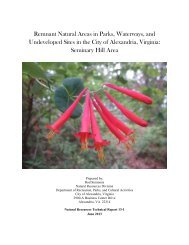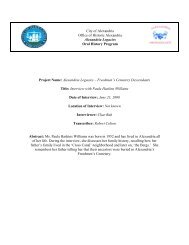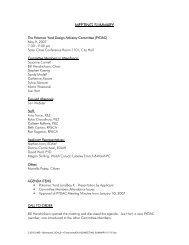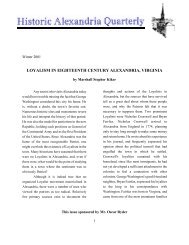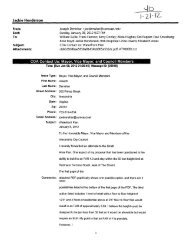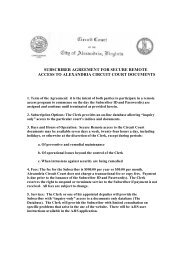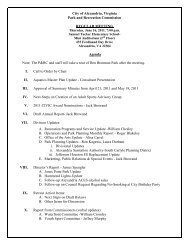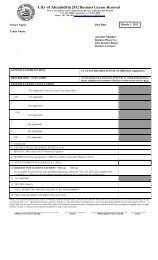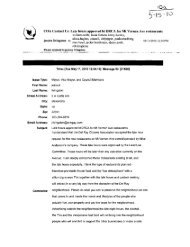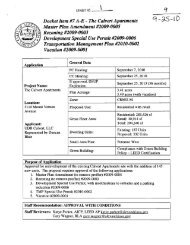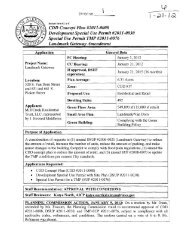Potomac Waterfront Flood Mitigation Study - City of Alexandria
Potomac Waterfront Flood Mitigation Study - City of Alexandria
Potomac Waterfront Flood Mitigation Study - City of Alexandria
Create successful ePaper yourself
Turn your PDF publications into a flip-book with our unique Google optimized e-Paper software.
Refinement <strong>of</strong> <strong>Mitigation</strong> Measures<br />
SECTION TWO: REFINEMENT OF MITIGATION MEASURES<br />
2.1 SUMMARY OF INITIAL FLOODING ASSESSMENT<br />
As part <strong>of</strong> this project, URS prepared the Initial <strong>Flood</strong>ing Assessment Report, dated October<br />
2007, which summarized flooding problems, identified their causes, and identified and<br />
categorized potential flood mitigation solutions. In addition, this report identified three types <strong>of</strong><br />
flooding events to be considered.<br />
The project considers three discrete flood events: nuisance flooding (elevation 4.0 feet North<br />
American Vertical Datum [NAVD]); intermediate flooding (elevation 8.0 feet NAVD); and<br />
extreme flooding (elevation 10.2 feet NAVD). The three flood events have return periods<br />
associated with them. A return period or recurrence interval is the estimated period <strong>of</strong> time<br />
between occurrences <strong>of</strong> equal-sized events. For example, the Federal Emergency Management<br />
Agency (FEMA) Base <strong>Flood</strong> has a return period <strong>of</strong> 100 years; therefore, it is referred to as the<br />
100-year flood or one percent annual flood. Figure 2-1 shows the inundation areas for selected<br />
flood-level categories.<br />
For the extreme and intermediate floods, the return period was interpolated from the <strong>City</strong> <strong>of</strong><br />
<strong>Alexandria</strong> and District <strong>of</strong> Columbia <strong>Flood</strong> Insurance Studies (FISs), specifically the <strong>Potomac</strong><br />
River flood pr<strong>of</strong>ile. The 6-foot flood elevation event was analyzed for a specific flood mitigation<br />
alternative that is discussed later in this report. A logarithmic equation was developed using all<br />
four flood elevations and known return intervals. For the nuisance flood, the return period was<br />
computed through a statistical regression analysis <strong>of</strong> a U.S. Geological Survey (USGS) tidal<br />
stream gage located on the <strong>Potomac</strong> River at Wisconsin Avenue in Washington, D.C. The return<br />
periods for the flood events are listed in Table 2-1.<br />
Table 2-1: Return Periods <strong>of</strong> Studied <strong>Flood</strong> Events<br />
<strong>Flood</strong> Event Elevation (feet NAVD) Return Period (years)<br />
Nuisance 4.0 1.5<br />
6-foot <strong>Flood</strong> (Elevated Walkway) 6.0 10<br />
Intermediate 8.0 30<br />
Extreme 10.2 100<br />
Figure 2-1 shows the areas <strong>of</strong> inundation for the 4-foot, 8-foot and 10.2 foot flood elevations.<br />
Figure 2-2 provides a graphical representation <strong>of</strong> Table 2-1, with additional reference points<br />
including the peak elevation <strong>of</strong> flooding during Hurricane Isabel, mean high and low water<br />
elevations and the relative height for a floodwall that would protect against the 100-year flood<br />
level with three feet <strong>of</strong> freeboard.<br />
28-JUL-10\\ 2-1



